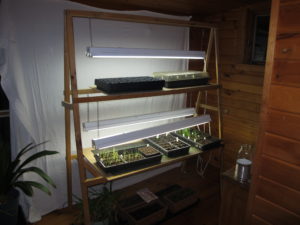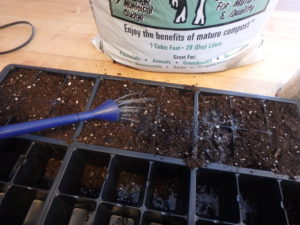Tips for Starting Seeds Indoors
By mid-March I generally am getting a bit squirrelly. Winter is nearly over but mud season is ahead. It is still many weeks until the snow is gone, the soil warm and dry enough that I can work in my garden. This is the time I like to start a few seedlings indoors to keep my spirits up.
If you’ve never tried starting plants indoors, there are a few things you should know:
- Lights are essential. Growing on a windowsill will only result in long, lanky and dispirited plants. Four-foot fluorescent or LED fixtures will provide plenty of light and help you to grow good plants.
- You can’t grow seedling indoors in soil. You need a potting mix to grow them in those little 6-packs available at the garden center.
- Temperature is important, too. Electric heat mats under your flats of seeds will help them to germinate earlier and better. After that? Not too hot. 65 degrees or less during the day and 50 to 55 at night are good temperatures.
- Plants quickly use up any fertilizer that comes in your potting soil. If you are an organic grower, you can water with a dilute fish or seaweed fertilizer to provide what is needed for healthy growth. But don’t make your dilution too strong. More is not better, so read the directions. Fertilize once or twice a week.
- Don’t let your seeds or seedlings dry out. Check daily.
- Timing is important. Most seedlings only need 6 to 8 weeks of growth indoors before going outside. You don’t want your plants to get root bound. Most seed packages or catalogs will give you information about timing.
- Seedlings need their rest, too. Don’t run your lights all the time. They need 10 hours or more of rest – no lights – each 24 hours.
Start the process by setting up a growing area in a spare bedroom or bathroom or perhaps in the basement. Depending on your budget and how many seedlings you wish to start, you can use a card table and a fluorescent or LED fixture hung from the ceiling – or something more elaborate.
Years ago I built a simple A-frame plant-starting frame that I use every year. I used one inch-by two-inch pine boards. The legs are each 6 feet long and each pair of legs is joined using a small gate hinge at the top. The two pairs of legs are five feet apart, and connected on 3 levels with 1-by-2 inch wood to support lights and plywood platforms.
The A-frame has 3 growing areas: top shelf, middle shelf, and the floor. I used thin plywood for the two shelves, one piece 16 by 48 inches for the top shelf, the other 24 by 48 inches for the middle shelf.
I used short sections of 1-by-2 to brace the structure, including a piece between the side supports of the wider shelf, which might droop if not supported.
I placed cup hooks on the cross pieces to support the fluorescent lights on jack chain, one 2-bulb fixture for the top shelf, 2 two-bulb fixtures for the other growing areas. This system will handle up to 10 flats of seedlings. Of course, you don’t have to use it all, especially when you are just learning how to manage growing seedlings indoors.
The jack-chain mentioned above is a light-weight chain that is sold in hardware stores. You can open up the chain on each end with needle-nose pliers to attach it to a hook or to poke into slot on the back of the fixtures. It’s important to have something you can easily adjust in length, as you will want to keep the lights about 6 inches above your plants. My tomatoes get more than a foot tall, so I keep shortening the chain to pull up the lights.
Fill your 6-packs with potting soil, wipe off any excess, and then water. The material will settle. Let it drain, and then plant. Make a divot with a pencil for each seed. The bigger the seed, the deeper the divot, per directions on seed packs. Or you can drop the seed on the surface, and push it into the potting mix with the eraser end of a pencil, and cover with more potting mix. Lightly water again.
What to plant indoors, what outdoors? Root crops should always be direct seeded outdoors, with the possible exception of beets. Although many plant cucumbers and squash by seed outdoors, I plant then indoors in May to prevent beetles from decimating them when they are small. I put them out when vines are about 6 inches long.
Tomatoes I usually start around April 10. The biodynamic calendar I use,
Stella Natura, tells me to plant fruit crops this year on Saturday afternoon, April 6 or Sunday afternoon, April 14th. I believe the sun and moon are good guides, and that calendar helps me.
Right now? I’m planting peppers, hot and sweet. Onions are good to plant by seed indoors in March, too, though you can buy plants or sets to plant outdoors later.
Try a few things indoors by seed this year if you haven’t before. I think you’ll enjoy it.
Henry can be reached at henry.homeyer@comcast.net or PO Box 364, Cornish Flat, NH 03746.





